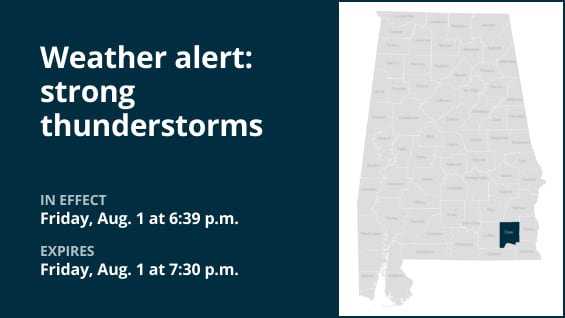At 6:39 p.m. on Friday, the National Weather Service updated its forecast for Dale County, predicting severe thunderstorms until 7:30 p.m.
Wind gusts of up to fifty miles per hour are possible for residents.
The meteorological service reports that at 6:38 p.m., “Doppler radar tracked a strong thunderstorm near Ozark, moving southeast at 15 mph.” “Gusty winds could knock down tree limbs and blow around unsecured objects.”
The following locations are affected by the alert: Arguta, Mabson, Snells Crossroads, Ewell, Dale County Lake, Marley Hill, Hwy 231 Pea River Bridge, Sylvan Grove, Greater Salem Church, Skipperville, Echo, Dean Church Road, Rocky Head, Bells Crossroads, Dill, Hooper Stage Field, Ariton, Ozark, and Fort Rucker.
“If outside, consider seeking shelter inside a building,” the weather agency warns. Alongside this storm is torrential rain, which could cause localized flooding. Avoid operating a car on flooded roads. Keep an eye on nearby radio stations and accessible television stations for more updates and any National Weather Service alerts as this storm may get stronger.
Lightning on the horizon: Expert safety measures for thunderstorms
Approximately 25 million lightning strikes occur in the United States annually, most of which take place in the summer. The weather service reports that lightning is the cause of death for about 20 persons each year. As thunderstorms get closer, the risk of lightning increases; it peaks when the storm is directly overhead and then progressively decreases as it passes.
Think about the following suggestions to make sure you’re safe during a thunderstorm.:
Plan for lightning safety:
-
When venturing outdoors, it’s vital to establish a clear plan for seeking shelter in case of lightning.
-
Stay vigilant by monitoring the sky for ominous signs and listening for the telltale sound of thunder. If thunder is audible, it’s a clear indication of nearby lightning.
-
Seek shelter promptly in a safe location, preferably indoors.
Indoor safety precautions:
-
Once you’ve found shelter indoors, abstain from using corded phones, electrical appliances, or plumbing fixtures, and refrain from approaching windows and doors.
-
These precautions help reduce the risk of electrical surges, as lightning can follow conductive pathways.
Hold off till the all-clear:
-
After the last lightning strike or thunderclap, wait at least 30 minutes before resuming outdoor activities.
-
Lightning can strike even when a storm has seemingly passed, so exercise caution.
When there is no indoor shelter:
Take these precautions to increase your safety if you are outside during a thunderstorm without access to indoor shelter:
-
Avoid open fields, hilltops, or ridge crests, which expose you to greater lightning risk.
-
Steer clear of tall, isolated trees and other prominent objects. In forested areas, stay close to lower stands of trees.
-
If you’re in a group, ensure that individuals are spaced out to prevent lightning current from transferring between people.
-
Camping in an open setting during a thunderstorm is strongly discouraged. If no alternative exists, set up camp in a valley, ravine, or other low-lying areas. Remember that a tent offers no protection against lightning.
-
Do not approach water bodies, wet objects, or metal items. While water and metal don’t attract lightning, they conduct electricity effectively and can pose significant risks.
In conclusion, readiness and alertness are your greatest allies while dealing with the threat of lightning. You may put your safety first and drastically lower the chance of lightning-related mishaps by adhering to these rules.
Navigating rainy roads: Safety tips for wet weather
If heavy rainfall persists or if runoff is substantial, flooding may result. Saturated soils and/or heavy rainfall can cause excessive runoff. To keep safe during periods of intense rain, heed these weather service recommendations:
Watch out for flooding rivers:
When it rains a lot, stay clear from parking or strolling near culverts or drainage ditches since the swift-moving water could carry you away.
Keep your distances from other vehicles safe:
To keep a safe following distance behind the car in front of you, follow the two-second rule. To account for decreased traction and braking efficiency in heavy weather, give yourself an extra two seconds.
Reduce your speed and exercise caution:
Reduce your speed if it’s raining and the roads are wet. Reduce your speed gently by taking your foot off the accelerator. Never apply the brakes abruptly since this could cause the vehicle to slide.
Pick your lane carefully:
Water tends to pool in the outside lanes, so stick to the central ones.
Visibility is important.
Turn on your headlights to improve visibility in severe rain. Rain-stained windows can hide cars in blind zones, so be cautious.
Be cautious on slick roads:
Roads are slickest during the first half-hour of rain because of a combination of rain, oil, and filth. Be especially careful during this time.
Stay a safe distance away from big cars:
Tire spray from big vehicles and buses can make it harder to see. Pass them quickly and safely, and refrain from tailgating.
Be mindful of your wipers:
Visibility may be hampered by overloaded wiper blades. If the rain makes it very difficult to see, stop and wait for the weather to clear up. Look for cover in covered areas or rest areas.
If you can’t avoid the roadside, pull off as far as you can, ideally past the end of a guard rail, and wait for the storm to pass. To let other cars know where you are, turn on your emergency flashers and keep your headlights on.
You may greatly lower dangers and protect your health when it rains a lot by adhering to these safety precautions. To ensure a safe and sound voyage, keep yourself updated on weather conditions and follow local authorities’ instructions.
United Robots offers a service called Advance Local Weather Alerts that gathers the most recent information from the National Weather Service using machine learning.






